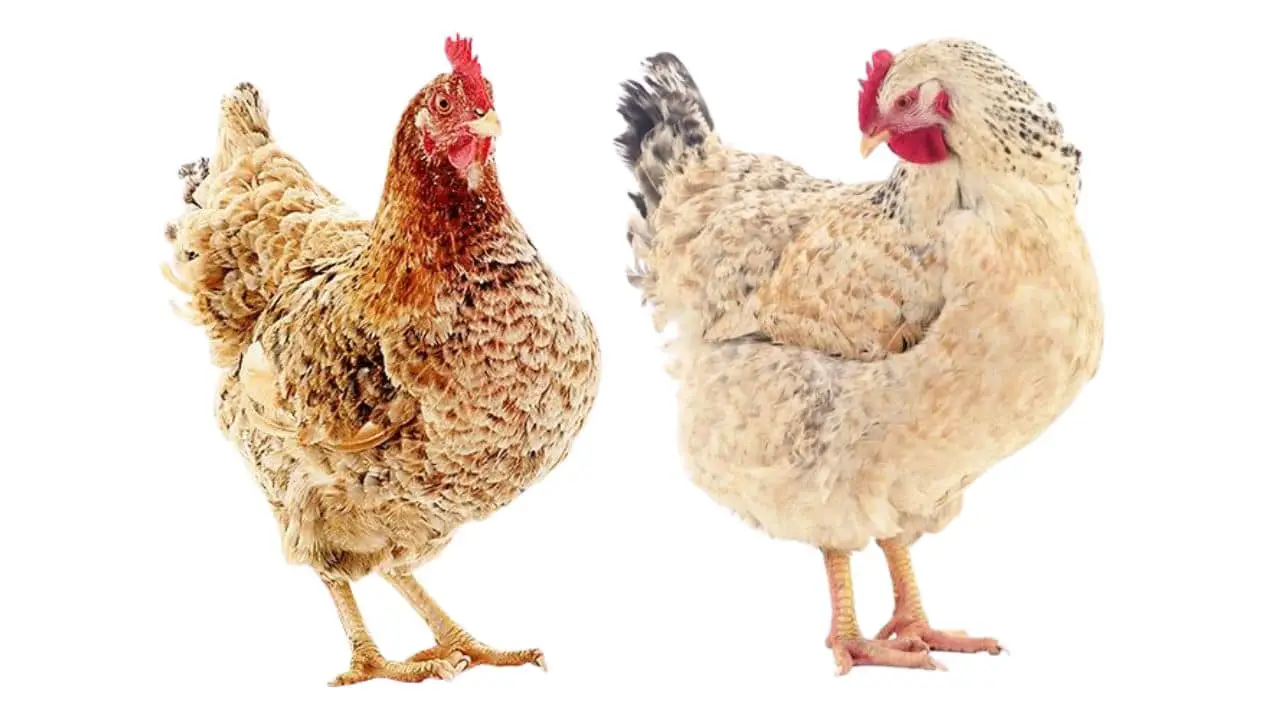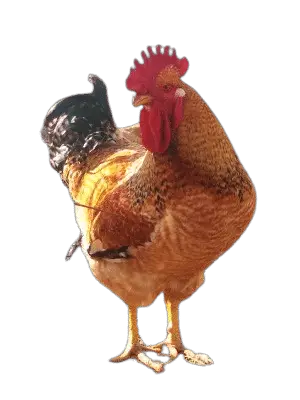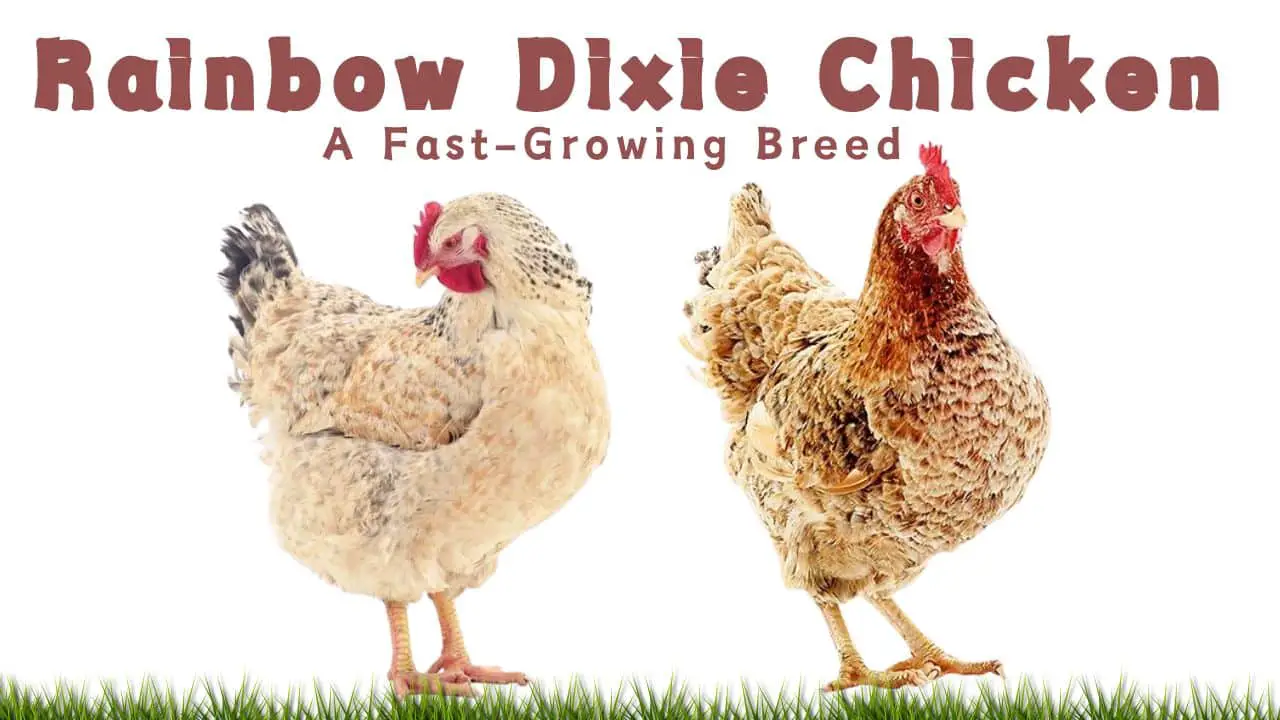Rainbow Dixie Chickens are well known for their fast growth and development; they are among the fastest-growing chickens.
The term “Rainbow” reflects the variety of colors and patterns available in this breed; every Dixie chicken is entirely different from one another. They are also a dual-purpose breed, which means they are prolific egg layers and a good meat producer.
This blog post will examine all the fantastic things you need to know about Rainbow Dixie Chickens.
Let’s get started!
Overview of Rainbow Dixie Chickens
|
S and G Poultry introduced these chickens in the US |
|
| Originated | From several breeds |
| Developed | In Europe |
| Weight at Maturity | Rooster: 3.2–3.6 kg (7–8 lbs), Hen: 2.3–2.7 kg (5–6 lbs) |
| Purpose | Egg & Meat production |
| Egg Production: | 220–250 eggs per year means 4–5 eggs per week |
| Egg Color | Brown or Light Brown |
| Eggs Size | Medium to Large |
| Temperament and Personality | Calm, confident, sweet, and friendly |
| Broodiness | High |
| Hardiness: | Cold and Heat hardy |
| Lifespan | Between 5–8 years |
| Maturity Period | 12-13 Weeks |
| Beginner Friendly | Yes, perfect for beginners or new bird keepers |
Brief History of Rainbow Dixie Chickens
Rainbow Dixie Chickens are a hybrid, originating from several different breeds like Cornish, white rock, New Hampshire, and Rhode Island red.
Some years back, these chickens were developed in Europe and later they were introduced in the US by S and G Poultry.
Brown Dixie Rainbow chickens are a variety of dixie chickens, which were created in recent years by backyard chicken enthusiasts who wanted to introduce a new variety and level of beauty to their flocks or backyards.
Appearance of Rainbow Dixie Chickens
The word “Rainbow” refers to their diverse and different colors and patterns. You will find Rainbow Dixie Chicken in various shades of white and pale brownish hues, tan and brown, many with a speckled look.
The feather colors and pattern variations are unreal. Some sport golden hues, others rock pale brownish tones, and mine even has a small flick of black like winged eyeliner!
Their comb and wattles glow red, while roosters strut with tail feathers held high. Hens have a compact body and broad breast, giving them a sturdy, large size. At 17 weeks, their comb was full, and their wattles were growing, proving their fast growth.
Every Rainbow Dixie Chicken has a unique color scheme and feathering pattern; you can’t find them in the same colors and patterns.
They have vibrant colors, resembling rainbows, single medium-sized combs, and compact bodies with round and broad breasts.
In the point of weighing a mature male weighs around 8 pounds while a mature female weighs around 6 pounds. However, their weight depends on many factors like their feed, health, environment, etc.
When they reach market weight at around 12-13 weeks of age, they are ready to produce meat, and you can enjoy their flavorful meat.
Characteristics of Rainbow Dixie Chickens
Here are the characteristics of this mesmerizing chicken breed:
-
Temperament and Personality
Rainbow Dixie Chicken has a calm and confident personality. Their confidence inspires us and makes them memorable and interesting.
They are sweet and affectionate birds and love to create a heartwarming connection with their owner.
Moreover, they are also quite protective of chickens, especially during mating, nesting, and laying seasons.
Expect some clucking, squawking, and cackling from the hens, plus crowing from rainbow roosters. It’s lively but not overwhelming.
-
Hardiness and Adaptability
These chickens are quite hardy and adaptable to various environmental conditions and climate changes.
Whether you live in a hot or cold region the Rainbow Dixie Chicken will thrive easily, this by their robust nature.
-
Fast Growth Rate
Rainbow Dixie Chicken is well known for their standout feature: fast and rapid growth and development.
These birds don’t mess around. Roosters hit 7-8 lbs at maturity, while hens settle at 5-6 lbs. For meat production, they reach market weight around 12-13 weeks. You will be shocked to see how fast these chickens are growing.
-
Eggs and Meat Production
If you love fresh eggs, you’re in for a treat. Hens lay 225-250 eggs a year, starting at 20-24 weeks. Their medium-large brown eggs fill egg basket with dark brown and light brown beauties.
Occasionally, you will snag a double yolk, which is a bonus! Pair them with Easter Eggers for blue egg layers or Olive Eggers for green, and your egg carton becomes a rainbow.
You can read our guide on boosting chicken’s egg-laying ability whenever they stop or lay slowly.
-
Broodiness of Rainbow Dixie
These ladies are broody and wonderful mothers. Their protective vibe makes them perfect for hatching chicks. These chickens are highly broody; they show a keen interest in sitting and hatching their eggs.
Incubating and hatching their eggs requires ensuring that the eggs are fertilized, meaning that they are from a hen mated with a rooster.
The whole process of sitting and hatching eggs takes 21 days.
Care for Rainbow Dixie Chickens
Rainbow Dixie requires proper care to thrive. Here are some tips for taking good care of your chickens:
Coop:
Rainbow Dixie chickens need a spacious and well-ventilated coop with plenty of room to move around.
The coop should also have enough nesting boxes for the hens, perches for roosting, a heater or lamp for winter, and space for food and water dishes. Keep the coop clean and dry to prevent any health issues.
Diet:
A high-quality diet is essential for the well-being of Rainbow Dixie chickens. Provide a balanced mix of grains, seeds, and vegetables.
Provide them with access to fresh water in a waterer at all times. Additionally, avoid feeding them any unhealthy treats as it can cause health issues.
Grooming:
Rainbow Dixie chickens have beautiful feathers that require regular grooming. Gently brushing their feathers will help remove dirt and debris, keeping their coat clean and healthy.
It is also important to regularly trim their nails and beaks to prevent overgrowth.
Healthcare:
Vaccination against salmonellosis and parasite checks are key. Grim \nails and beak for grooming, watching her leg development to avoid ascites. Their hardiness, both cold and heat-hardy, means they thrive anywhere.

Conclusion
Dixie Rainbow Chickens are versatile, adaptable, and beginner-friendly. With vibrant colors, flavorful meat, and top-notch egg production, they’re a win for poultry keepers.
Their meat quality and egg-laying shine, backed by 2023 hatchery stats showing a 15% rise in hybrid demand. So, grab some chicks, set up your brooder, and let these dual-purpose birds brighten your backyard!
Check reputable hatcheries like Abendroth or The Chick Hatchery for female chicks or mixes. They’re a hit with backyard flocks for a reason!
How many feathered friends do you have in your flock? Feel free to share your thoughts with us.
FAQs
What is the lifespan of Rainbow Dixie Chicken?
Rainbow Dixie Chickens can live between 5 and 8 years; however, their lifespan depends on many factors, such as diet, environment, health care, etc.
Are Rainbow Dixie Chickens suitable for small backyard spaces?
As they are medium to large birds, this depends on their size. If they are medium in size, they don’t need ample space, but if they are large, they do.
What color eggs do Dixie Rainbow chickens lay?
The color of Rainbow Dixie Chicken is brown or light brown.
Where can one purchase Rainbow Dixie Chicken?
As Rainbow Dixie Chicken is a hybrid, you can find them in specialized hatcheries like Hoover’s Hatchery.
Is Rainbow Dixie Chicken aggressive?
No, they are calm but confident and sweet birds.
Can I eat the meat and eggs of Rainbow Dixie Chicken?
Yes, you can eat and enjoy their meat and eggs.
Are Rainbow Dixie Chicken good for new chicken keepers?
Yes, they are a perfect choice for beginners or new poultry keepers because they don’t require any special care.
What is the cost of Rainbow Dixie Chicken?
For straight-run chicks, the prices generally range from $3 to $4. A Female Dixie Rainbow chick will cost $4 to $7, while a Male Dixie Rainbow chick will cost between $2 and $5. A mature Dixie Rainbow can cost between $10 to $50. Their prices depend on their color, health, and personality.

Hello! I’m Ibrahim, the owner and writer of this blog. I run a chicken farm with 160 chickens, and I’ve gained a lot of knowledge about raising and caring for them. Now, I want to share my insights and experiences with you to help you in chicken keeping.


2 thoughts on “Rainbow Dixie Chicken | A Fastest Growing Breed”